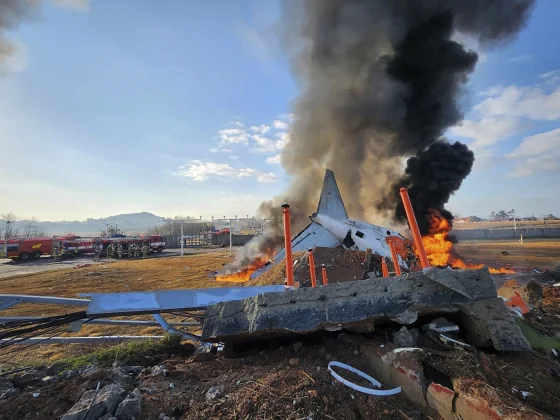Deadliest airline disaster of the year
The national fire agency confirmed the deaths of 179 people, making it the deadliest airline disaster of the year and what appears to be the first fatal accident since the low-cost airline was founded in 2005.
The agency said it had determined the identities of at least 88 of the victims. As the confirmed death toll ticked up, anxious families gathered at the airport, awaiting news of their loved ones. An announcer carefully read out the names of those confirmed dead.
Screams and cries erupted from family members as the identities were confirmed according to reports by the South Korean news agency Newsis. The Red Cross set up tents to provide privacy for grieving family members.
At least, 84 of the dead were women and 82 were men. The genders of 11 other victims were not immediately identifiable.
Two crew members — a man and a woman — were rescued; they sustained moderate injuries but were conscious, Joo said.
South Korea’s Yonhap news agency reported that one of them, a 33-year-old flight attendant identified with his surname, Lee, sustained multiple injuries, including fractured ribs and traumatic spinal injuries, according to Ju Woong, director of Ewha Woman’s University Seoul Hospital, where Lee was transferred.
“When I woke up, I had already been rescued,” Ju said Lee told the doctors, adding that he was in intensive care but was able to communicate well. “There’s no indication yet of memory loss or such,” Ju said.
The other survivor, a 25-year-old woman with the surname Koo, was taken to Asan Medical Center in Seoul. Koo reportedly sustained injuries to her ankle and head and was stable.
A bird strike likely set off the disaster
Joo, the aviation official, gave an outline of the sequence of events leading to the disaster.
The pilots initially tried to land on the airport’s Runway 1, he said, but control tower instructed them to land on the opposite side, Runway 19, because of a bird strike warning. A bird strike is a collision between a bird and an aircraft.
A minute later, the pilots sent a mayday signal following a bird strike and tried to land on Runway 19.
As it was passing over the runway, the plane failed to lower its landing gear and struck a safety system called a localizer — which provides guidance during landing — and it crashed into a wall, Joo said.
The crash happened at around 9:03 a.m. local time (7:03 p.m. ET Saturday), and firefighters put out the initial blaze at 9:46 a.m. local time, the fire agency spokesperson said.
The plane was “completely destroyed by fire,” Joo said at a briefing, adding investigators have retrieved both the flight data recorder and the cockpit voice recorder, which will be key to providing insights into the plane’s last moments.
The full investigation, he said, could take six months to three years.
The National Transportation Safety Board is leading an American team, including Boeing and the Federal Aviation Administration, that will assist South Korea in investigating.
In a statement, President Joe Biden said the U.S. “stands ready to provide any necessary assistance” to Korea.
“As close allies, the American people share deep bonds of friendship with the South Korean people and our thoughts and prayers are with those impacted by this tragedy,” he said.
Eyewitness Lee Geun-Young was in his restaurant, less than a quarter-mile from the airport, when he heard loud banging noises coming from outside, he told the South Korean newspaper Seoul Shinmun.
“Instead of heading toward the runway, the plane flew right over our store,” Lee, 49, said as he described the last moments of the ill-fated aircraft. Lee said he watched the plane as it turned around to attempt a landing on the runway.
“This plane was turning in a much tighter radius,” he said. “It felt dangerous, so I immediately went up to the rooftop and started filming.”
The plane, a Boeing 737-800, is a narrow-body passenger jet that is used widely by airlines around the world. It is part of the Boeing’s Next-Generation family, and it is one of the company’s safest airplanes.
Boeing extended its condolences to the victims’ families and said it was in contact with the airline. In a statement, Jeju Air extended its apologies to “everyone affected” by the incident.
“Above all, we offer our heartfelt condolences and apologies to the passengers who tragically lost their lives in the accident and to their bereaved families,” CEO Kim E-bae said, assuming “full responsibility for this tragedy” and adding that the airline would provide support for the families.
South Korea’s acting president, Choi Sang-mok, called for immediate and full mobilization efforts “to put out the fire and rescue people,” the Ministry of the Interior and Safety said in a statement.

